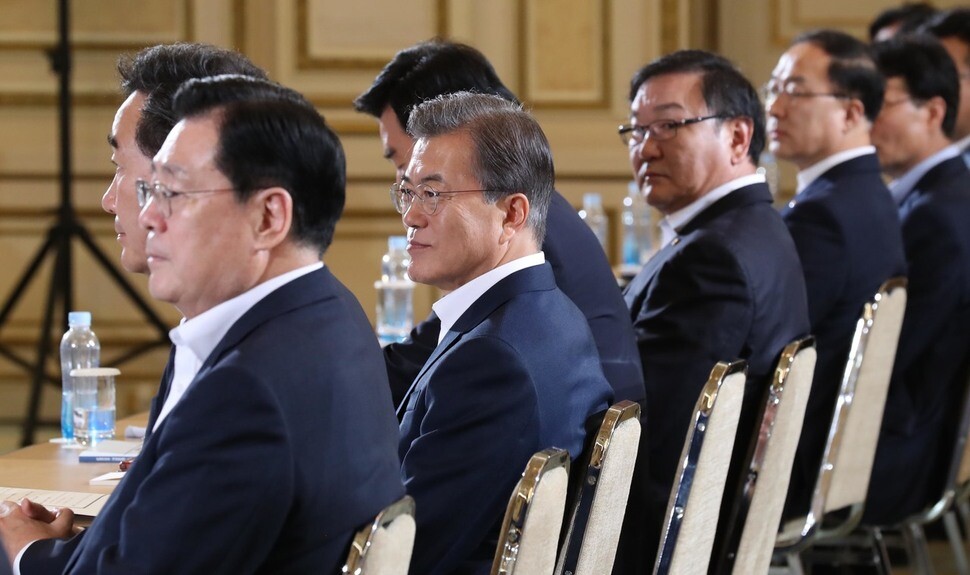hankyoreh
Links to other country sites 다른 나라 사이트 링크
Moon admin.’s governance plan signals step back on pushing for OPCON transfer

The list of 100 governance tasks announced by the Moon Jae-in administration‘s Planning and Advisory Committee on July 19 stated that the transfer of wartime operational control (OPCON) to South Korea would be “pursued at an early date.”
A document distributed to the media beforehand by the committee listed governance task #86 as “Transferring OPCON within Moon’s term based on a firm South Korea-US alliance (Ministry of National Defense).” But a Blue House official notified reporters of the revision that morning, explaining that the “wording about ‘within the term’ has been changed to ‘at an early date.’”
“This was a presidential order, since it was something agreed upon by the two leaders at the South Korea-US summit,” the official explained - a reference to the joint statement on June 30 stating that the South Korean and US Presidents had “decided to continue the Alliance’s work to expeditiously enable the conditions-based transfer of wartime operational control of ROK forces.”
Moon also discussed the OPCON transfer timeline in a luncheon the same day with the leaders of four political parties. “I decided not to specify the [transfer] timeline and to revise ’within my term‘ to ’at an early date,‘” he explained.
The decision not to specify an OPCON transfer date marks a step back from Moon’s initial pledge as a presidential candidate. The next question is whether the Moon administration has weakened in its commitment to getting OPCON - the operational authority currently wielded by the Combined Forces Command commander (also commander of US Forces Korea) over South Korean forces - before his term ends in 2022.
“We need time to get the conditions in place for an OPCON transfer. We also have to take the situation with North Korea’s nuclear and missile advancements into account,” a Blue House official said.
The Planning and Advisory Committee also said it would be formulating a “Defense Reform 2.0” plan once a special defense reform committee is established under the president. Its tasks are to include reducing the mandatory military service period to 18 months, cutting troop numbers to 500,000, revising the command structure, increasing soldiers’ pay to 50% of the minimum wage, expanding the presence of women in the armed forces, civilianizing defense, and stepping up prevention and punishment for defense industry corruption.
In terms of inter-Korean relations, the focus was set on restoring communication channels, dialogue at various levels, and athletic, religious, and academic exchange. The administration also reaffirmed its pursuit of a “new economic map for the Korean Peninsula” involving the creation of three belts: an inter-Korean energy-resource belt on the East Sea, an industry-distribution belt on the West (Yellow) Sea, and an environment-tourism belt at the Demilitarized Zone (DMZ).
On the North Korean nuclear issue, the administration said it would be pursuing resumed denuclearization talks with the development of a plan for comprehensive negotiations aimed at proceeding from a freeze to total abandonment of nuclear capabilities by 2020.
By Park Byong-su, senior staff writer, and Lee Se-young, staff reporter
Please direct questions or comments to [english@hani.co.kr]

Editorial・opinion
![[Column] Park Geun-hye déjà vu in Yoon Suk-yeol [Column] Park Geun-hye déjà vu in Yoon Suk-yeol](https://flexible.img.hani.co.kr/flexible/normal/500/300/imgdb/original/2024/0424/651713945113788.jpg) [Column] Park Geun-hye déjà vu in Yoon Suk-yeol
[Column] Park Geun-hye déjà vu in Yoon Suk-yeol![[Editorial] New weight of N. Korea’s nuclear threats makes dialogue all the more urgent [Editorial] New weight of N. Korea’s nuclear threats makes dialogue all the more urgent](https://flexible.img.hani.co.kr/flexible/normal/500/300/imgdb/original/2024/0424/7317139454662664.jpg) [Editorial] New weight of N. Korea’s nuclear threats makes dialogue all the more urgent
[Editorial] New weight of N. Korea’s nuclear threats makes dialogue all the more urgent- [Guest essay] The real reason Korea’s new right wants to dub Rhee a founding father
- [Column] ‘Choson’: Is it time we start referring to N. Korea in its own terms?
- [Editorial] Japan’s rewriting of history with Korea has gone too far
- [Column] The president’s questionable capacity for dialogue
- [Column] Are chaebol firms just pizza pies for families to divvy up as they please?
- [Column] Has Korea, too, crossed the Rubicon on China?
- [Correspondent’s column] In Japan’s alliance with US, echoes of its past alliances with UK
- [Editorial] Does Yoon think the Korean public is wrong?
Most viewed articles
- 1[Column] Park Geun-hye déjà vu in Yoon Suk-yeol
- 2Will NewJeans end up collateral damage in internal feud at K-pop juggernaut Hybe?
- 3N. Korean hackers breached 10 defense contractors in South for months, police say
- 4[Editorial] New weight of N. Korea’s nuclear threats makes dialogue all the more urgent
- 5[Cine feature] A new shift in the Korean film investment and distribution market
- 6Up-and-coming Indonesian group StarBe spills what it learned during K-pop training in Seoul
- 7[Column] The clock is ticking for Korea’s first lady
- 8Terry Anderson, AP reporter who informed world of massacre in Gwangju, dies at 76
- 9Thursday to mark start of resignations by senior doctors amid standoff with government
- 10Kim Jong-un expressed ‘satisfaction’ with nuclear counterstrike drill directed at South